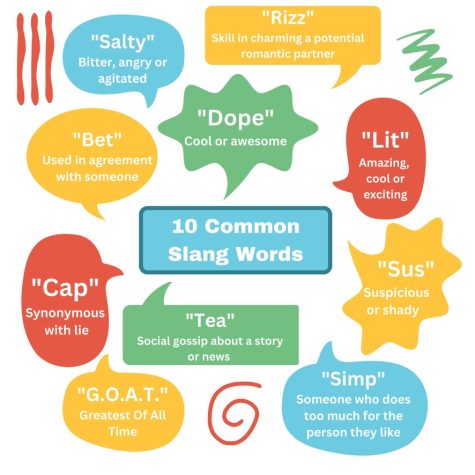The way high schoolers talk is wack. No cap. From the key elements of language like pronunciation, grammar, and vocabulary to the small details like power dynamics and eye contact language in the teenage world is low-key important AF.
Dr. Teresa Pratt is a sociolinguistics professor at San Francisco State University, she studies how people use differences in language to construct the social world around us. “People always use language as a way to creatively express themselves,” Pratt said.
Just how language varies based on gender, sexuality, ethnicity, culture or region the way teenagers speak and use language is affected by a variety of factors. Social pressure and cliques, rebellious desires, differentiation from adults, a teen’s character and social position can all affect the way teenagers speak. Language is more than a tool of communication; the way you speak can convey just as much information as what you say.
“Everything that I say when I describe how to get to the grocery store tells you things about me. Am I warm and friendly? Or am I rude? Those things get connected to things like gender and even class, whether you’re working class, or you’re very high class…variation is part of how language works and has always been that way,” Pratt said. “We can use language in so many different ways to construct and project who we are… language is a form of self-expression.”
Across the world, there are infinite groups in which language variation displays itself. The distinctive ways that teenagers use language is just one example of language variation. Marcus Aghili, a sophomore at Redwood who was born and grew up in New York has noticed such variation in language.
“the way people say things can determine where [they] are from and the different groups they represent.”
There is not one correct way to speak, “Standard language is a myth,” Pratt said. “There is no one way that everyone speaks… and there’s no one right way to speak either…variation is an amazing thing.”
Pronunciation
Pronunciation is how a word is pronounced or spoken. Changes in pronunciation often stem from accents. Unlike vocabulary and grammar, which can change relatively quickly, a change in pronunciation, called “sound change,” is gradual.
“Over generations, you’ll pronounce your vowels just a little bit differently from your parents, and your parents will have pronounced their vowels just a little bit differently from their parents. It changes over time,” Pratt said.
At Redwood, distinctive pronunciation differences are not very noticeable except for students’ individual speech variations. Large-scale pronunciation differences can be seen in California when compared to the East Coast, Midwest, or the South. People on the West Coast tend to pronounce their consonants more heavily and often raise their pitch at the end of a word, whereas someone from the Midwest would elongate their vowels and speak with a wide and flat sound. One example in California is how the vowel in a word like track, or class is starting to sound more like “trock” or “closs.”
While these pronunciation trends do not apply to everyone in a certain region, they are widely followed and exemplify language variation over regional groups.

Grammar
According to Encyclopedia Britannica, grammar is defined as the “rules of a language governing the sounds, words, sentences, and other elements, as well as their combination and interpretation.”. Grammatical variation is prevalent when comparing teenagers to other age groups. One example is the informality present in the teenage language; the overuse of run-on sentences, usually connected with coordinating conjunctions like “and,” is a major difference between teens and their parents. Younger generations also use more filler words than older generations do such as “like” and “yeah.”
“I feel like I use the word ‘like’ a lot, which is very Californian. And I think a lot of [students] also use it a lot,” Aghili said.
This informality is spurred on by the excessive use of texting by teens, where punctuation is non-existent and abbreviations are frequent.
Vocabulary
Another linguistical area where language varies across groups and regions is vocabulary. “One of the classic examples in US English is if you say ‘pop’, or ‘soda’, or in the south ‘Coke.’ It all means the same thing but it depends on where you are that you’ll hear one word or another,” Pratt said.
Variation of vocabulary in teenagers is seen predominantly with the use of slang; informal words usually used by a specific group of people. Slang arises in a variety of ways, and takes form under different circumstances.
“New words are always being added to languages, humans are always innovating language…we have an aptitude for [creating new words], it’s a very creative process,” Pratt said.
Words such as “fire” or “lit” have different meanings to youth today, both mean “amazing” or “exciting,” while to older generations the definition would be much more literal. The vocabulary and slang teens use is constantly changing, which can be a hassle for those trying to stay up to date.
Origins of Teenage Variation
“Variation has always been central to how language works,” Pratt said.
When there are social groups, variation in language will inevitably develop. In the high school environment, language variation is even more likely.
Especially in the modern world, social factors and pressure encourage language variation in teen communities. How someone speaks can help define their identity and the groups they align with. This makes language an important cultural aspect that varies between different high school cliques, tropes, or social groups.
“At a certain age, you have the opportunity for self-expression in a new way. It’s on display, especially in the way we do schooling [in the United States],” Pratt said. “Social groups emerge, and then there’s all this distinction [and] work to distinguish yourself from that group or this group.”
Aside from the social aspects, teens often want to differentiate themselves from adults.
“After World War II, in western industrialized countries, the idea of being a teenager emerged as something people of that age align with. So, there’s a distinction between ‘I’m a young person, you’re an older person,” Pratt said.
By using slang, teens differentiate themselves from adults in their life.
“[Slang] allows people to connect and talk to each other in a less formal way than talking to adults,” Aghili said.
Similar to this is the excessive teenage use of cursing.
“You cuss more when you’re young because it’s rebellious and you’re trying to get away with something,” Pratt said.
Teenagers want to align with their own age and people, so it’s expected that these distinctions emerge to differentiate themselves from other groups.
“The fact that you and I use language differently is a cool thing, not a bad thing,” Pratt said.
When it comes to variation, at Redwood language can both unite and divide. What’s important is the relationship that you have to language.
“You have to think about language as a creative, interesting thing to pay attention to,” Pratt said. “If we could work towards a world where there’s less control and [where we’re not] trying to police other people’s language, we could get everyone having a more joyful experience of language as self-expression.”







